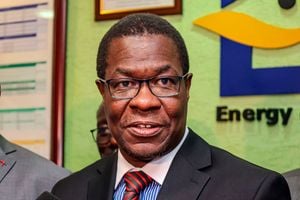The media as women’s ally in amplifying voices, championing inclusion

The cover of the Voice magazine's 91st edition.
What you need to know:
- Women continue to be underrepresented in decision-making roles, with systemic barriers propelled by patriarchy and misogyny persisting across industries, leading to premature exits from the workforce.
- One of the most pressing challenges facing women in Kenya today is gender-based violence, which remains alarmingly prevalent, despite years of advocacy and awareness-raising efforts.
The media as women’s ally in amplifying voices and championing inclusion
As the world observes this year's International Women's Day (last Friday), it serves as an important moment for reflection on the strides made towards gender equality and inclusion, while also igniting a call for sustained action.
Despite witnessing an increase in the representation of women in elected public offices, achieving true gender parity remains elusive.
Also read: Media has big role in gender equality effort
Women continue to be underrepresented in decision-making roles, with systemic barriers propelled by patriarchy and misogyny persisting across industries, leading to premature exits from the workforce.
One of the most pressing challenges facing women in Kenya today is gender-based violence (GBV), which remains alarmingly prevalent, despite years of advocacy and awareness-raising efforts.
GBV knows no boundaries, affecting women of all ages, backgrounds, and social statuses.
Also read: Have more women lead media
From domestic violence and sexual assault to harmful practices like female genital mutilation (FGM), women continue to bear the brunt of this pervasive human rights violation.
The alarming rise in cases of femicide and the persistent presence of GBV, morphing into various forms, both online and physical, underscores the urgent need for action, particularly in attaining the two-thirds gender principle in Kenya.
Though the current landscape may appear far from ideal, significant progress has indeed been achieved in elevating women's issues and advancing women’s rights.
Amidst these challenges, the media has emerged as a powerful ally in championing women's empowerment and advocacy.
Through its multifaceted platforms (radio, television, print, and digital), the media has played a crucial role in shaping public discourse, amplifying women's voices, and catalysing legal and policy reforms in Kenya.
The Kenyan media stands out for its contribution to women's empowerment and advocacy.
By raising awareness and driving advocacy for change, media platforms are instrumental in propelling the women's rights movement forward and influencing policy.
The media serves as a key driver of public awareness of critical issues affecting women. Investigative journalism exposes GBV cases and discriminatory practices such as FGM, compelling conversations and demanding accountability from authorities, as well as pushing for the implementation of the gender rule in Kenya.
Documentaries and reports showcasing the struggles and triumphs of women leaders, activists, and entrepreneurs have helped to spark dialogues on achieving gender equality.
Also read: Why women are missing in the news, daily
The intersectionality of gender with other factors such as ethnicity, socioeconomic status, and disability further exacerbates disparities, leaving marginalised women even more vulnerable to exclusion and discrimination.
Addressing these systemic inequalities requires a concerted effort to dismantle patriarchal structures, promote women's leadership, and create enabling environments for their participation in governance at all levels.
In addition to awareness creation, the media plays a crucial role in empowering women by providing a platform for their voices and stories to be heard.
Also read: Put more funds into gender equity
Women in Kenya make use of various outlets such as television and panel interviews, talk shows, podcasts, and online forums to tell their stories, highlight their manifestos, and report on development issues.
Female journalists and storytellers have shared their unique perspectives, experiences, and voices, fostering a sense of community and empowering collective action.
By utilising tools like radio listening groups, allies of women’s rights such as the men's engagement forums, organisations like Amwik have successfully implemented behavioural change initiatives.
Additionally, media coverage of women inspiring progressive change across different fields challenges existing gender stereotypes.
Moreover, the media has been instrumental in advocating legal and policy changes that affect women's rights.
Civil society has leveraged media platforms to campaign for legislative reforms on issues like GBV, sexual and reproductive health and rights, women's leadership and governance, and equitable land ownership.
Recently, civil society organisations in Kenya called for the expedited resolution of GBV cases and the establishment of special GBV courts within the Judiciary and Policare centres in police stations.
Investigative reporting has shed light on areas needing reform and holds authorities accountable for upholding women's rights.
For example, documentaries focusing on the challenges faced by teenage mothers during the Covid-19 crisis have brought attention and sparked conversations at the national level, attracting the attention of key stakeholders in the education and health sectors.
Community media stations have been critical tools used to advance women's participation in local politics and development, easily engaging with their constituents.
These stations have raised awareness, facilitated local dialogues on critical women's rights issues, and connected women to essential resources in both the national and international spaces.
In the digital realm, social media platforms have emerged as powerful tools for women to connect, share experiences, organise movements, and amplify their voices on a global scale.
The #MeToo movement, for instance, had a profound global impact, shedding light on the prevalence of sexual harassment across various divides.
However, women’s participation on social media platforms is facing an imminent threat from abuse, gendered disinformation and misinformation, doxing, deep fake, hence rolling back the gains made towards inspiring inclusion in previous years.
Despite the undeniable contributions of the media to advancing women's rights in Kenya, challenges persist.
Limited access to resources, sexual harassment, and training for female journalists, particularly in community media, poses obstacles to storytelling.
Gender biases and stereotypes within the media itself can perpetuate harmful narratives and underrepresent women's stories.
Increased inclusion of women in leadership positions across all divides is essential to ensure a more balanced and representative society that champions the rights of women inspiring inclusion.
The writer is the acting executive director, Amwik





